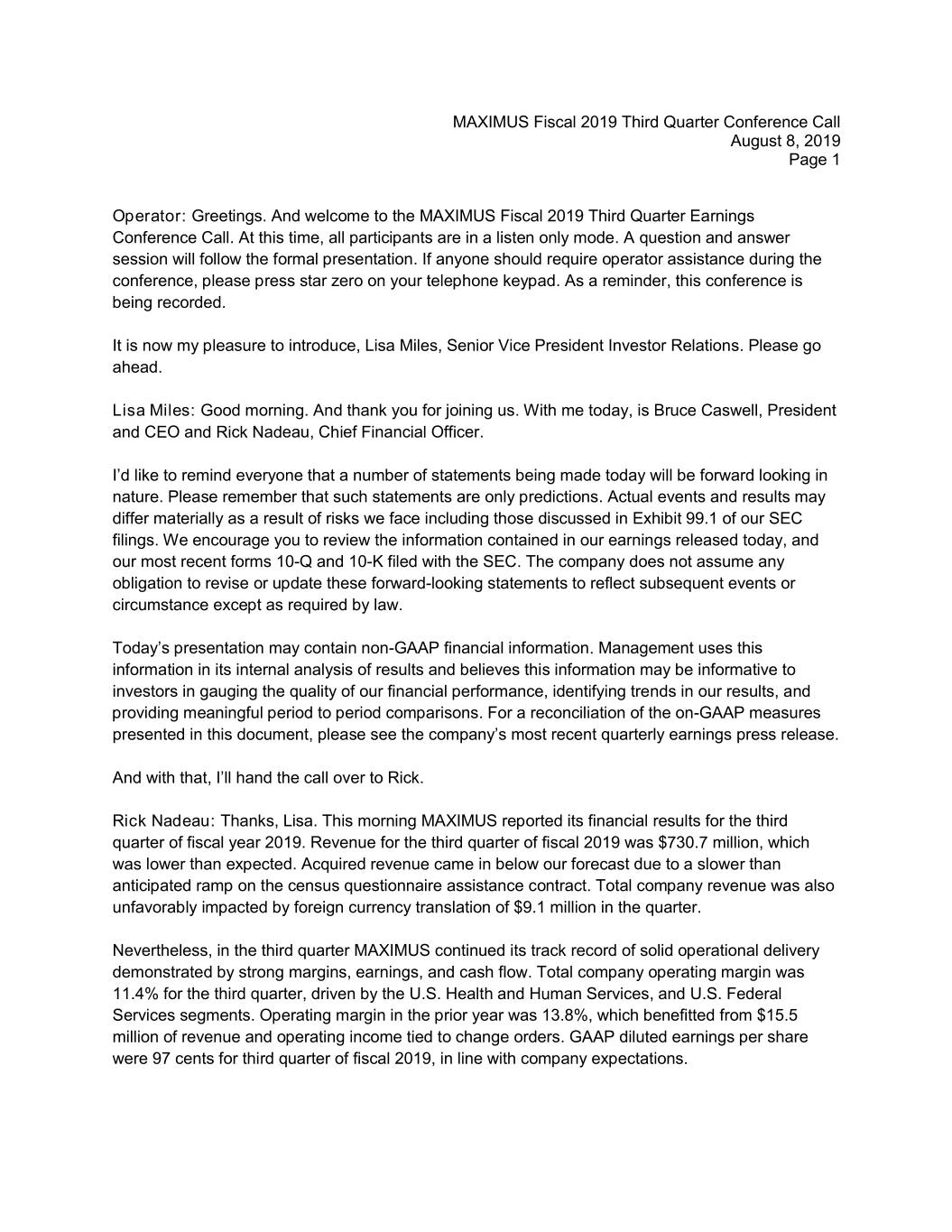
MAXIMUS Fiscal 2019 Third Quarter Conference Call August 8, 2019 Page 1 Operator: Greetings. And welcome to the MAXIMUS Fiscal 2019 Third Quarter Earnings Conference Call. At this time, all participants are in a listen only mode. A question and answer session will follow the formal presentation. If anyone should require operator assistance during the conference, please press star zero on your telephone keypad. As a reminder, this conference is being recorded. It is now my pleasure to introduce, Lisa Miles, Senior Vice President Investor Relations. Please go ahead. Lisa Miles: Good morning. And thank you for joining us. With me today, is Bruce Caswell, President and CEO and Rick Nadeau, Chief Financial Officer. I’d like to remind everyone that a number of statements being made today will be forward looking in nature. Please remember that such statements are only predictions. Actual events and results may differ materially as a result of risks we face including those discussed in Exhibit 99.1 of our SEC filings. We encourage you to review the information contained in our earnings released today, and our most recent forms 10-Q and 10-K filed with the SEC. The company does not assume any obligation to revise or update these forward-looking statements to reflect subsequent events or circumstance except as required by law. Today’s presentation may contain non-GAAP financial information. Management uses this information in its internal analysis of results and believes this information may be informative to investors in gauging the quality of our financial performance, identifying trends in our results, and providing meaningful period to period comparisons. For a reconciliation of the on-GAAP measures presented in this document, please see the company’s most recent quarterly earnings press release. And with that, I’ll hand the call over to Rick. Rick Nadeau: Thanks, Lisa. This morning MAXIMUS reported its financial results for the third quarter of fiscal year 2019. Revenue for the third quarter of fiscal 2019 was $730.7 million, which was lower than expected. Acquired revenue came in below our forecast due to a slower than anticipated ramp on the census questionnaire assistance contract. Total company revenue was also unfavorably impacted by foreign currency translation of $9.1 million in the quarter. Nevertheless, in the third quarter MAXIMUS continued its track record of solid operational delivery demonstrated by strong margins, earnings, and cash flow. Total company operating margin was 11.4% for the third quarter, driven by the U.S. Health and Human Services, and U.S. Federal Services segments. Operating margin in the prior year was 13.8%, which benefitted from $15.5 million of revenue and operating income tied to change orders. GAAP diluted earnings per share were 97 cents for third quarter of fiscal 2019, in line with company expectations.
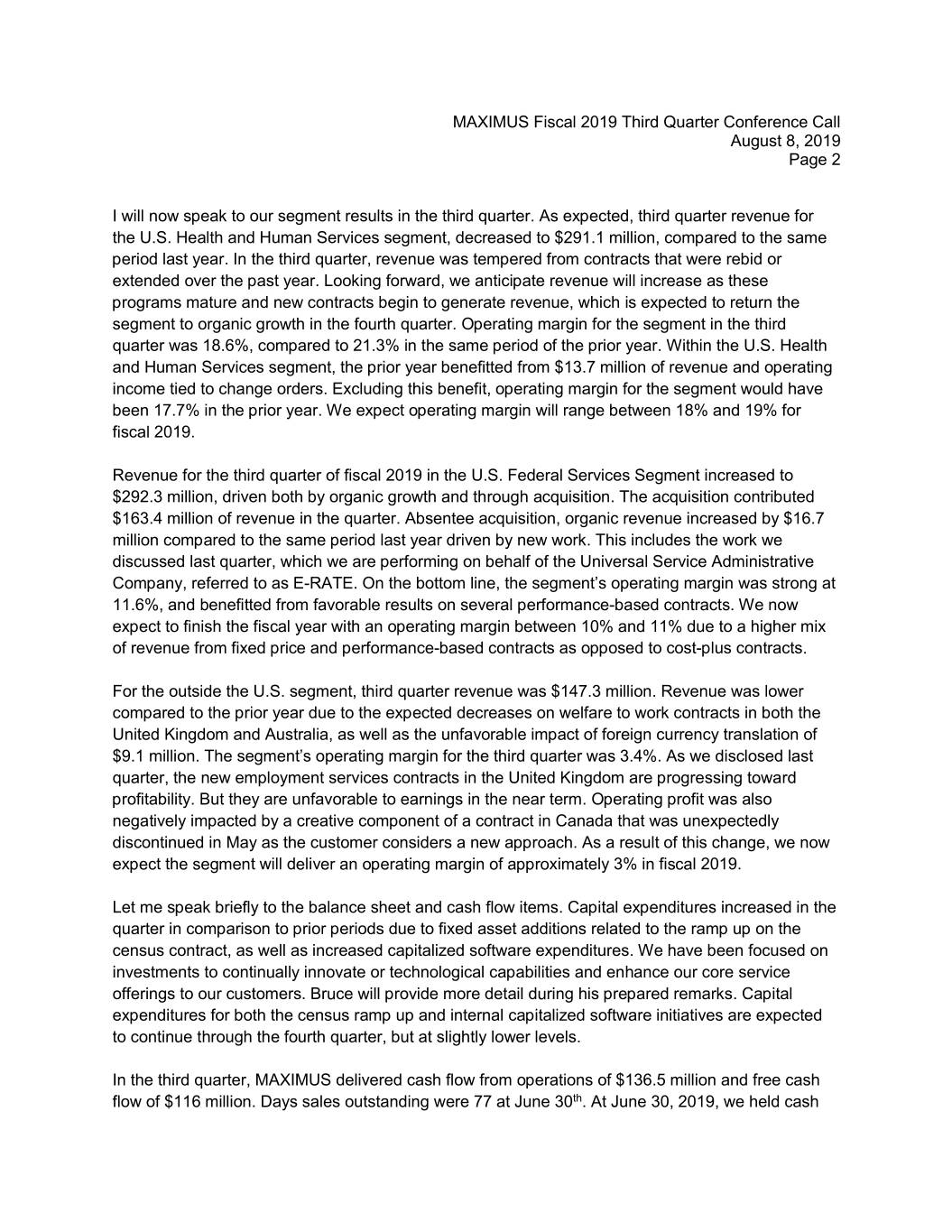
MAXIMUS Fiscal 2019 Third Quarter Conference Call August 8, 2019 Page 2 I will now speak to our segment results in the third quarter. As expected, third quarter revenue for the U.S. Health and Human Services segment, decreased to $291.1 million, compared to the same period last year. In the third quarter, revenue was tempered from contracts that were rebid or extended over the past year. Looking forward, we anticipate revenue will increase as these programs mature and new contracts begin to generate revenue, which is expected to return the segment to organic growth in the fourth quarter. Operating margin for the segment in the third quarter was 18.6%, compared to 21.3% in the same period of the prior year. Within the U.S. Health and Human Services segment, the prior year benefitted from $13.7 million of revenue and operating income tied to change orders. Excluding this benefit, operating margin for the segment would have been 17.7% in the prior year. We expect operating margin will range between 18% and 19% for fiscal 2019. Revenue for the third quarter of fiscal 2019 in the U.S. Federal Services Segment increased to $292.3 million, driven both by organic growth and through acquisition. The acquisition contributed $163.4 million of revenue in the quarter. Absentee acquisition, organic revenue increased by $16.7 million compared to the same period last year driven by new work. This includes the work we discussed last quarter, which we are performing on behalf of the Universal Service Administrative Company, referred to as E-RATE. On the bottom line, the segment’s operating margin was strong at 11.6%, and benefitted from favorable results on several performance-based contracts. We now expect to finish the fiscal year with an operating margin between 10% and 11% due to a higher mix of revenue from fixed price and performance-based contracts as opposed to cost-plus contracts. For the outside the U.S. segment, third quarter revenue was $147.3 million. Revenue was lower compared to the prior year due to the expected decreases on welfare to work contracts in both the United Kingdom and Australia, as well as the unfavorable impact of foreign currency translation of $9.1 million. The segment’s operating margin for the third quarter was 3.4%. As we disclosed last quarter, the new employment services contracts in the United Kingdom are progressing toward profitability. But they are unfavorable to earnings in the near term. Operating profit was also negatively impacted by a creative component of a contract in Canada that was unexpectedly discontinued in May as the customer considers a new approach. As a result of this change, we now expect the segment will deliver an operating margin of approximately 3% in fiscal 2019. Let me speak briefly to the balance sheet and cash flow items. Capital expenditures increased in the quarter in comparison to prior periods due to fixed asset additions related to the ramp up on the census contract, as well as increased capitalized software expenditures. We have been focused on investments to continually innovate or technological capabilities and enhance our core service offerings to our customers. Bruce will provide more detail during his prepared remarks. Capital expenditures for both the census ramp up and internal capitalized software initiatives are expected to continue through the fourth quarter, but at slightly lower levels. In the third quarter, MAXIMUS delivered cash flow from operations of $136.5 million and free cash flow of $116 million. Days sales outstanding were 77 at June 30th. At June 30, 2019, we held cash
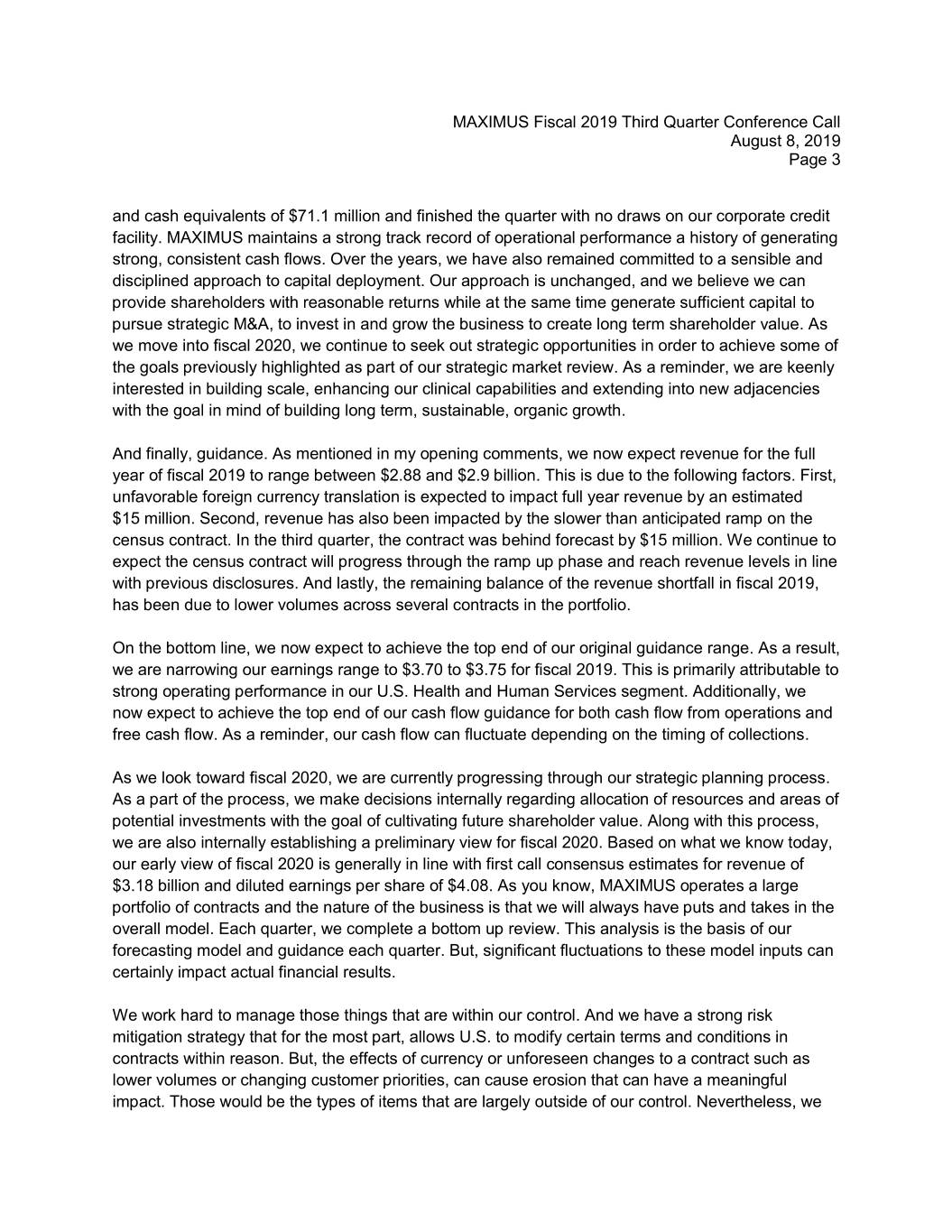
MAXIMUS Fiscal 2019 Third Quarter Conference Call August 8, 2019 Page 3 and cash equivalents of $71.1 million and finished the quarter with no draws on our corporate credit facility. MAXIMUS maintains a strong track record of operational performance a history of generating strong, consistent cash flows. Over the years, we have also remained committed to a sensible and disciplined approach to capital deployment. Our approach is unchanged, and we believe we can provide shareholders with reasonable returns while at the same time generate sufficient capital to pursue strategic M&A, to invest in and grow the business to create long term shareholder value. As we move into fiscal 2020, we continue to seek out strategic opportunities in order to achieve some of the goals previously highlighted as part of our strategic market review. As a reminder, we are keenly interested in building scale, enhancing our clinical capabilities and extending into new adjacencies with the goal in mind of building long term, sustainable, organic growth. And finally, guidance. As mentioned in my opening comments, we now expect revenue for the full year of fiscal 2019 to range between $2.88 and $2.9 billion. This is due to the following factors. First, unfavorable foreign currency translation is expected to impact full year revenue by an estimated $15 million. Second, revenue has also been impacted by the slower than anticipated ramp on the census contract. In the third quarter, the contract was behind forecast by $15 million. We continue to expect the census contract will progress through the ramp up phase and reach revenue levels in line with previous disclosures. And lastly, the remaining balance of the revenue shortfall in fiscal 2019, has been due to lower volumes across several contracts in the portfolio. On the bottom line, we now expect to achieve the top end of our original guidance range. As a result, we are narrowing our earnings range to $3.70 to $3.75 for fiscal 2019. This is primarily attributable to strong operating performance in our U.S. Health and Human Services segment. Additionally, we now expect to achieve the top end of our cash flow guidance for both cash flow from operations and free cash flow. As a reminder, our cash flow can fluctuate depending on the timing of collections. As we look toward fiscal 2020, we are currently progressing through our strategic planning process. As a part of the process, we make decisions internally regarding allocation of resources and areas of potential investments with the goal of cultivating future shareholder value. Along with this process, we are also internally establishing a preliminary view for fiscal 2020. Based on what we know today, our early view of fiscal 2020 is generally in line with first call consensus estimates for revenue of $3.18 billion and diluted earnings per share of $4.08. As you know, MAXIMUS operates a large portfolio of contracts and the nature of the business is that we will always have puts and takes in the overall model. Each quarter, we complete a bottom up review. This analysis is the basis of our forecasting model and guidance each quarter. But, significant fluctuations to these model inputs can certainly impact actual financial results. We work hard to manage those things that are within our control. And we have a strong risk mitigation strategy that for the most part, allows U.S. to modify certain terms and conditions in contracts within reason. But, the effects of currency or unforeseen changes to a contract such as lower volumes or changing customer priorities, can cause erosion that can have a meaningful impact. Those would be the types of items that are largely outside of our control. Nevertheless, we
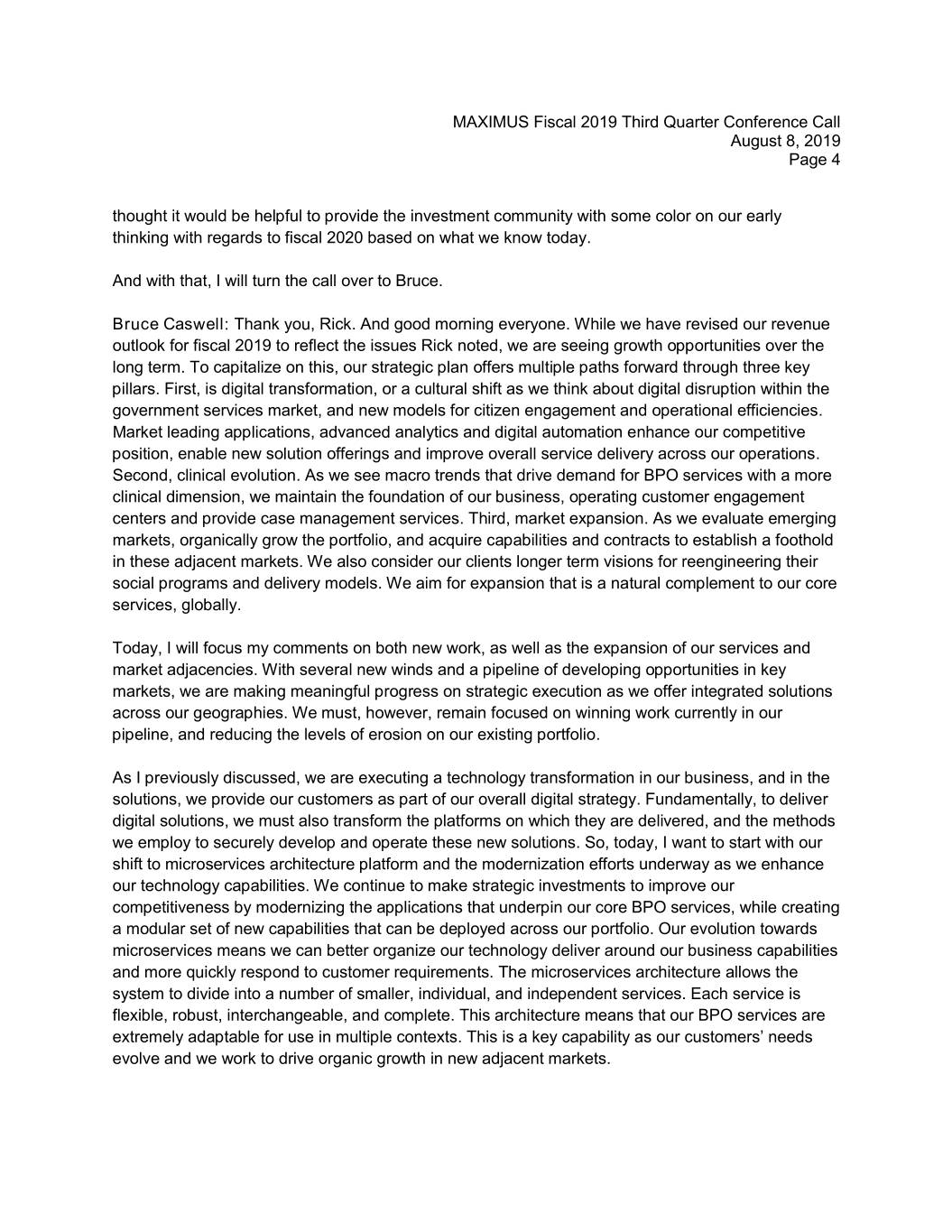
MAXIMUS Fiscal 2019 Third Quarter Conference Call August 8, 2019 Page 4 thought it would be helpful to provide the investment community with some color on our early thinking with regards to fiscal 2020 based on what we know today. And with that, I will turn the call over to Bruce. Bruce Caswell: Thank you, Rick. And good morning everyone. While we have revised our revenue outlook for fiscal 2019 to reflect the issues Rick noted, we are seeing growth opportunities over the long term. To capitalize on this, our strategic plan offers multiple paths forward through three key pillars. First, is digital transformation, or a cultural shift as we think about digital disruption within the government services market, and new models for citizen engagement and operational efficiencies. Market leading applications, advanced analytics and digital automation enhance our competitive position, enable new solution offerings and improve overall service delivery across our operations. Second, clinical evolution. As we see macro trends that drive demand for BPO services with a more clinical dimension, we maintain the foundation of our business, operating customer engagement centers and provide case management services. Third, market expansion. As we evaluate emerging markets, organically grow the portfolio, and acquire capabilities and contracts to establish a foothold in these adjacent markets. We also consider our clients longer term visions for reengineering their social programs and delivery models. We aim for expansion that is a natural complement to our core services, globally. Today, I will focus my comments on both new work, as well as the expansion of our services and market adjacencies. With several new winds and a pipeline of developing opportunities in key markets, we are making meaningful progress on strategic execution as we offer integrated solutions across our geographies. We must, however, remain focused on winning work currently in our pipeline, and reducing the levels of erosion on our existing portfolio. As I previously discussed, we are executing a technology transformation in our business, and in the solutions, we provide our customers as part of our overall digital strategy. Fundamentally, to deliver digital solutions, we must also transform the platforms on which they are delivered, and the methods we employ to securely develop and operate these new solutions. So, today, I want to start with our shift to microservices architecture platform and the modernization efforts underway as we enhance our technology capabilities. We continue to make strategic investments to improve our competitiveness by modernizing the applications that underpin our core BPO services, while creating a modular set of new capabilities that can be deployed across our portfolio. Our evolution towards microservices means we can better organize our technology deliver around our business capabilities and more quickly respond to customer requirements. The microservices architecture allows the system to divide into a number of smaller, individual, and independent services. Each service is flexible, robust, interchangeable, and complete. This architecture means that our BPO services are extremely adaptable for use in multiple contexts. This is a key capability as our customers’ needs evolve and we work to drive organic growth in new adjacent markets.
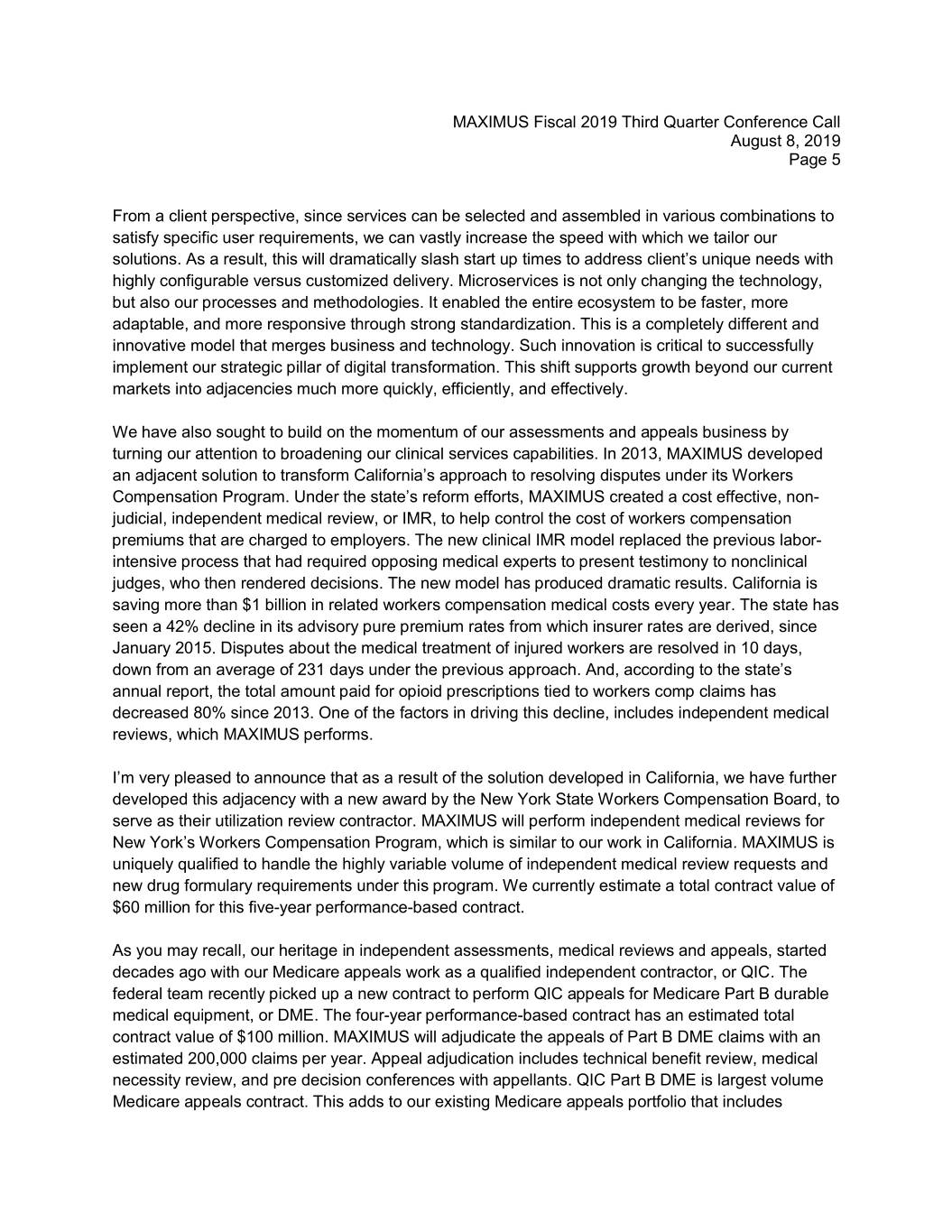
MAXIMUS Fiscal 2019 Third Quarter Conference Call August 8, 2019 Page 5 From a client perspective, since services can be selected and assembled in various combinations to satisfy specific user requirements, we can vastly increase the speed with which we tailor our solutions. As a result, this will dramatically slash start up times to address client’s unique needs with highly configurable versus customized delivery. Microservices is not only changing the technology, but also our processes and methodologies. It enabled the entire ecosystem to be faster, more adaptable, and more responsive through strong standardization. This is a completely different and innovative model that merges business and technology. Such innovation is critical to successfully implement our strategic pillar of digital transformation. This shift supports growth beyond our current markets into adjacencies much more quickly, efficiently, and effectively. We have also sought to build on the momentum of our assessments and appeals business by turning our attention to broadening our clinical services capabilities. In 2013, MAXIMUS developed an adjacent solution to transform California’s approach to resolving disputes under its Workers Compensation Program. Under the state’s reform efforts, MAXIMUS created a cost effective, non- judicial, independent medical review, or IMR, to help control the cost of workers compensation premiums that are charged to employers. The new clinical IMR model replaced the previous labor- intensive process that had required opposing medical experts to present testimony to nonclinical judges, who then rendered decisions. The new model has produced dramatic results. California is saving more than $1 billion in related workers compensation medical costs every year. The state has seen a 42% decline in its advisory pure premium rates from which insurer rates are derived, since January 2015. Disputes about the medical treatment of injured workers are resolved in 10 days, down from an average of 231 days under the previous approach. And, according to the state’s annual report, the total amount paid for opioid prescriptions tied to workers comp claims has decreased 80% since 2013. One of the factors in driving this decline, includes independent medical reviews, which MAXIMUS performs. I’m very pleased to announce that as a result of the solution developed in California, we have further developed this adjacency with a new award by the New York State Workers Compensation Board, to serve as their utilization review contractor. MAXIMUS will perform independent medical reviews for New York’s Workers Compensation Program, which is similar to our work in California. MAXIMUS is uniquely qualified to handle the highly variable volume of independent medical review requests and new drug formulary requirements under this program. We currently estimate a total contract value of $60 million for this five-year performance-based contract. As you may recall, our heritage in independent assessments, medical reviews and appeals, started decades ago with our Medicare appeals work as a qualified independent contractor, or QIC. The federal team recently picked up a new contract to perform QIC appeals for Medicare Part B durable medical equipment, or DME. The four-year performance-based contract has an estimated total contract value of $100 million. MAXIMUS will adjudicate the appeals of Part B DME claims with an estimated 200,000 claims per year. Appeal adjudication includes technical benefit review, medical necessity review, and pre decision conferences with appellants. QIC Part B DME is largest volume Medicare appeals contract. This adds to our existing Medicare appeals portfolio that includes
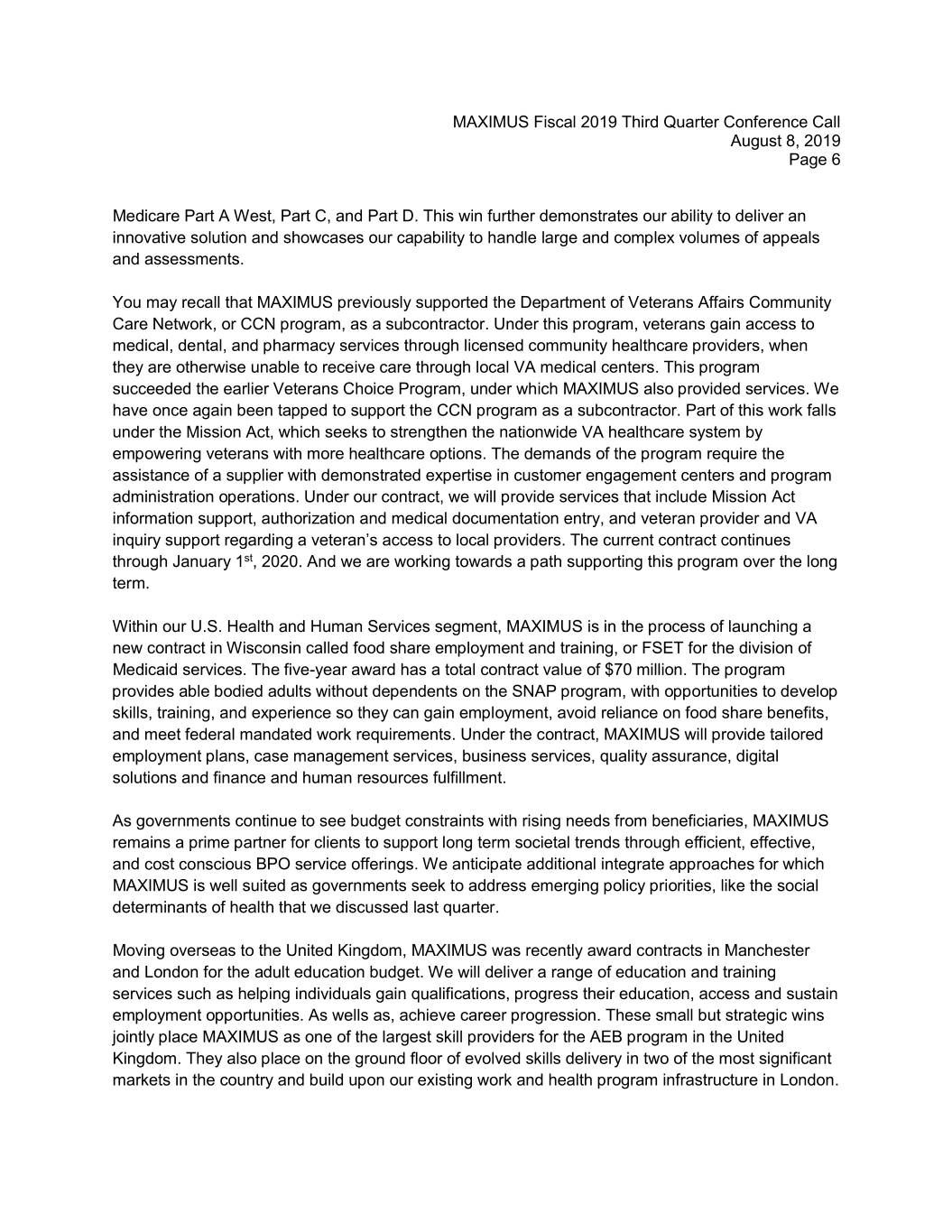
MAXIMUS Fiscal 2019 Third Quarter Conference Call August 8, 2019 Page 6 Medicare Part A West, Part C, and Part D. This win further demonstrates our ability to deliver an innovative solution and showcases our capability to handle large and complex volumes of appeals and assessments. You may recall that MAXIMUS previously supported the Department of Veterans Affairs Community Care Network, or CCN program, as a subcontractor. Under this program, veterans gain access to medical, dental, and pharmacy services through licensed community healthcare providers, when they are otherwise unable to receive care through local VA medical centers. This program succeeded the earlier Veterans Choice Program, under which MAXIMUS also provided services. We have once again been tapped to support the CCN program as a subcontractor. Part of this work falls under the Mission Act, which seeks to strengthen the nationwide VA healthcare system by empowering veterans with more healthcare options. The demands of the program require the assistance of a supplier with demonstrated expertise in customer engagement centers and program administration operations. Under our contract, we will provide services that include Mission Act information support, authorization and medical documentation entry, and veteran provider and VA inquiry support regarding a veteran’s access to local providers. The current contract continues through January 1st, 2020. And we are working towards a path supporting this program over the long term. Within our U.S. Health and Human Services segment, MAXIMUS is in the process of launching a new contract in Wisconsin called food share employment and training, or FSET for the division of Medicaid services. The five-year award has a total contract value of $70 million. The program provides able bodied adults without dependents on the SNAP program, with opportunities to develop skills, training, and experience so they can gain employment, avoid reliance on food share benefits, and meet federal mandated work requirements. Under the contract, MAXIMUS will provide tailored employment plans, case management services, business services, quality assurance, digital solutions and finance and human resources fulfillment. As governments continue to see budget constraints with rising needs from beneficiaries, MAXIMUS remains a prime partner for clients to support long term societal trends through efficient, effective, and cost conscious BPO service offerings. We anticipate additional integrate approaches for which MAXIMUS is well suited as governments seek to address emerging policy priorities, like the social determinants of health that we discussed last quarter. Moving overseas to the United Kingdom, MAXIMUS was recently award contracts in Manchester and London for the adult education budget. We will deliver a range of education and training services such as helping individuals gain qualifications, progress their education, access and sustain employment opportunities. As wells as, achieve career progression. These small but strategic wins jointly place MAXIMUS as one of the largest skill providers for the AEB program in the United Kingdom. They also place on the ground floor of evolved skills delivery in two of the most significant markets in the country and build upon our existing work and health program infrastructure in London.
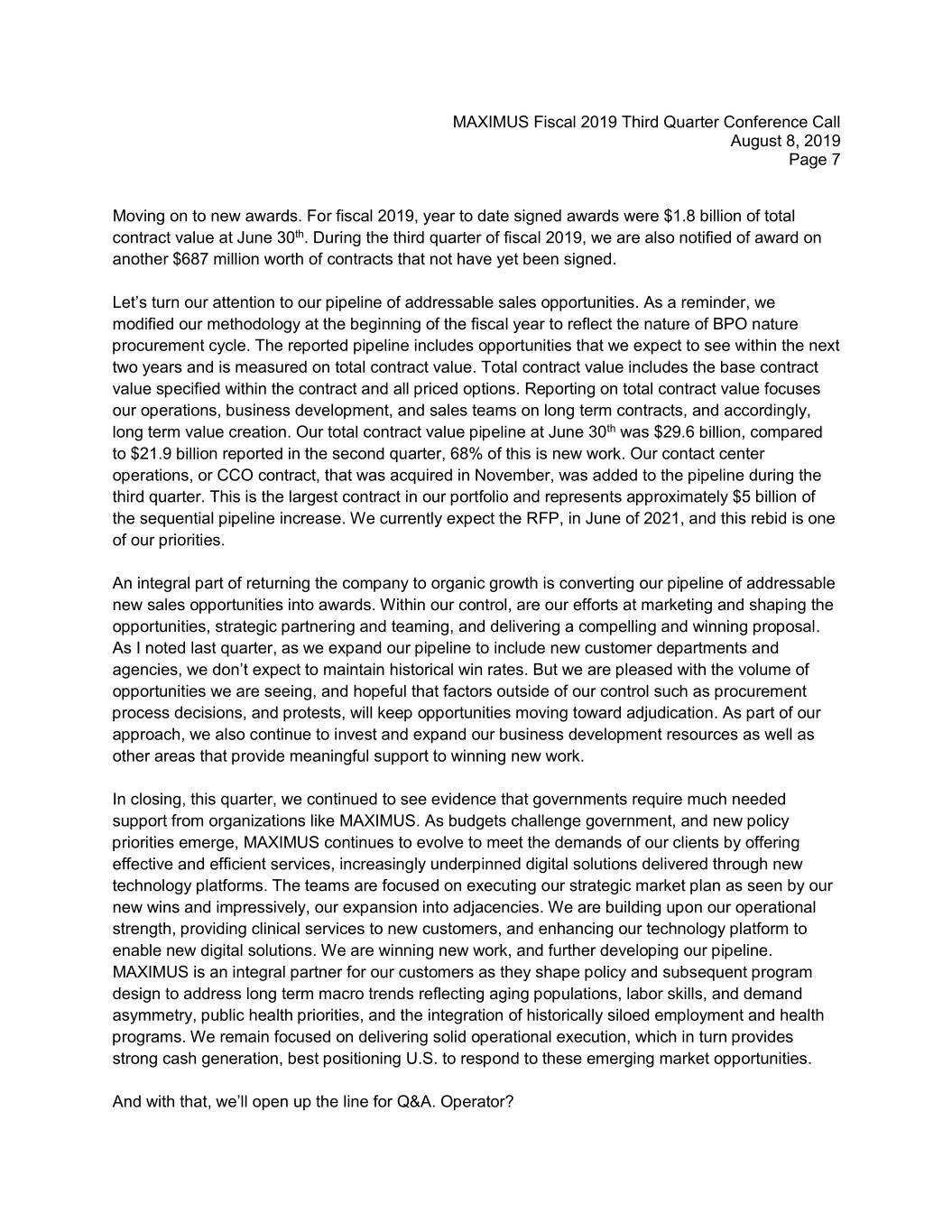
MAXIMUS Fiscal 2019 Third Quarter Conference Call August 8, 2019 Page 7 Moving on to new awards. For fiscal 2019, year to date signed awards were $1.8 billion of total contract value at June 30th. During the third quarter of fiscal 2019, we are also notified of award on another $687 million worth of contracts that not have yet been signed. Let’s turn our attention to our pipeline of addressable sales opportunities. As a reminder, we modified our methodology at the beginning of the fiscal year to reflect the nature of BPO nature procurement cycle. The reported pipeline includes opportunities that we expect to see within the next two years and is measured on total contract value. Total contract value includes the base contract value specified within the contract and all priced options. Reporting on total contract value focuses our operations, business development, and sales teams on long term contracts, and accordingly, long term value creation. Our total contract value pipeline at June 30th was $29.6 billion, compared to $21.9 billion reported in the second quarter, 68% of this is new work. Our contact center operations, or CCO contract, that was acquired in November, was added to the pipeline during the third quarter. This is the largest contract in our portfolio and represents approximately $5 billion of the sequential pipeline increase. We currently expect the RFP, in June of 2021, and this rebid is one of our priorities. An integral part of returning the company to organic growth is converting our pipeline of addressable new sales opportunities into awards. Within our control, are our efforts at marketing and shaping the opportunities, strategic partnering and teaming, and delivering a compelling and winning proposal. As I noted last quarter, as we expand our pipeline to include new customer departments and agencies, we don’t expect to maintain historical win rates. But we are pleased with the volume of opportunities we are seeing, and hopeful that factors outside of our control such as procurement process decisions, and protests, will keep opportunities moving toward adjudication. As part of our approach, we also continue to invest and expand our business development resources as well as other areas that provide meaningful support to winning new work. In closing, this quarter, we continued to see evidence that governments require much needed support from organizations like MAXIMUS. As budgets challenge government, and new policy priorities emerge, MAXIMUS continues to evolve to meet the demands of our clients by offering effective and efficient services, increasingly underpinned digital solutions delivered through new technology platforms. The teams are focused on executing our strategic market plan as seen by our new wins and impressively, our expansion into adjacencies. We are building upon our operational strength, providing clinical services to new customers, and enhancing our technology platform to enable new digital solutions. We are winning new work, and further developing our pipeline. MAXIMUS is an integral partner for our customers as they shape policy and subsequent program design to address long term macro trends reflecting aging populations, labor skills, and demand asymmetry, public health priorities, and the integration of historically siloed employment and health programs. We remain focused on delivering solid operational execution, which in turn provides strong cash generation, best positioning U.S. to respond to these emerging market opportunities. And with that, we’ll open up the line for Q&A. Operator?
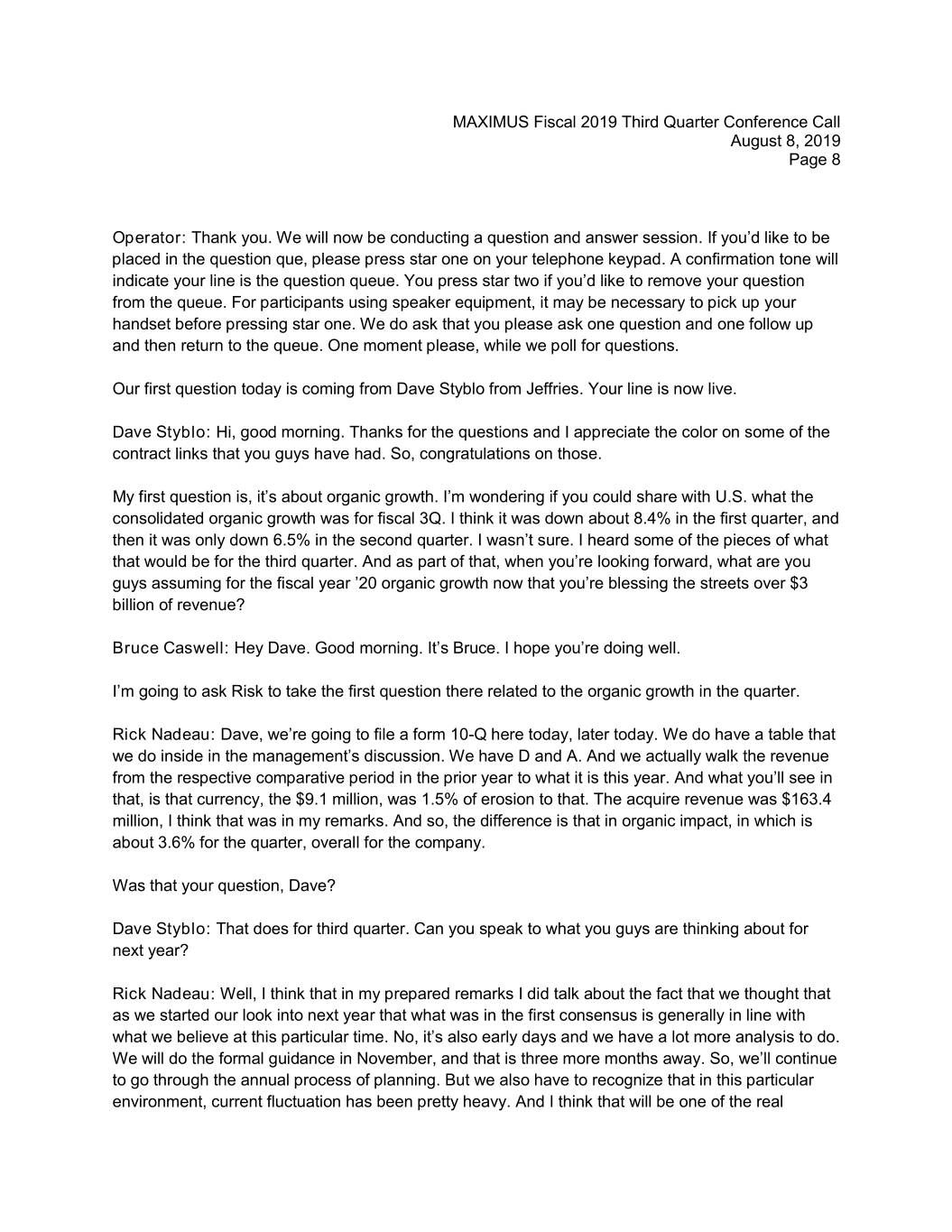
MAXIMUS Fiscal 2019 Third Quarter Conference Call August 8, 2019 Page 8 Operator: Thank you. We will now be conducting a question and answer session. If you’d like to be placed in the question que, please press star one on your telephone keypad. A confirmation tone will indicate your line is the question queue. You press star two if you’d like to remove your question from the queue. For participants using speaker equipment, it may be necessary to pick up your handset before pressing star one. We do ask that you please ask one question and one follow up and then return to the queue. One moment please, while we poll for questions. Our first question today is coming from Dave Styblo from Jeffries. Your line is now live. Dave Styblo: Hi, good morning. Thanks for the questions and I appreciate the color on some of the contract links that you guys have had. So, congratulations on those. My first question is, it’s about organic growth. I’m wondering if you could share with U.S. what the consolidated organic growth was for fiscal 3Q. I think it was down about 8.4% in the first quarter, and then it was only down 6.5% in the second quarter. I wasn’t sure. I heard some of the pieces of what that would be for the third quarter. And as part of that, when you’re looking forward, what are you guys assuming for the fiscal year ’20 organic growth now that you’re blessing the streets over $3 billion of revenue? Bruce Caswell: Hey Dave. Good morning. It’s Bruce. I hope you’re doing well. I’m going to ask Risk to take the first question there related to the organic growth in the quarter. Rick Nadeau: Dave, we’re going to file a form 10-Q here today, later today. We do have a table that we do inside in the management’s discussion. We have D and A. And we actually walk the revenue from the respective comparative period in the prior year to what it is this year. And what you’ll see in that, is that currency, the $9.1 million, was 1.5% of erosion to that. The acquire revenue was $163.4 million, I think that was in my remarks. And so, the difference is that in organic impact, in which is about 3.6% for the quarter, overall for the company. Was that your question, Dave? Dave Styblo: That does for third quarter. Can you speak to what you guys are thinking about for next year? Rick Nadeau: Well, I think that in my prepared remarks I did talk about the fact that we thought that as we started our look into next year that what was in the first consensus is generally in line with what we believe at this particular time. No, it’s also early days and we have a lot more analysis to do. We will do the formal guidance in November, and that is three more months away. So, we’ll continue to go through the annual process of planning. But we also have to recognize that in this particular environment, current fluctuation has been pretty heavy. And I think that will be one of the real
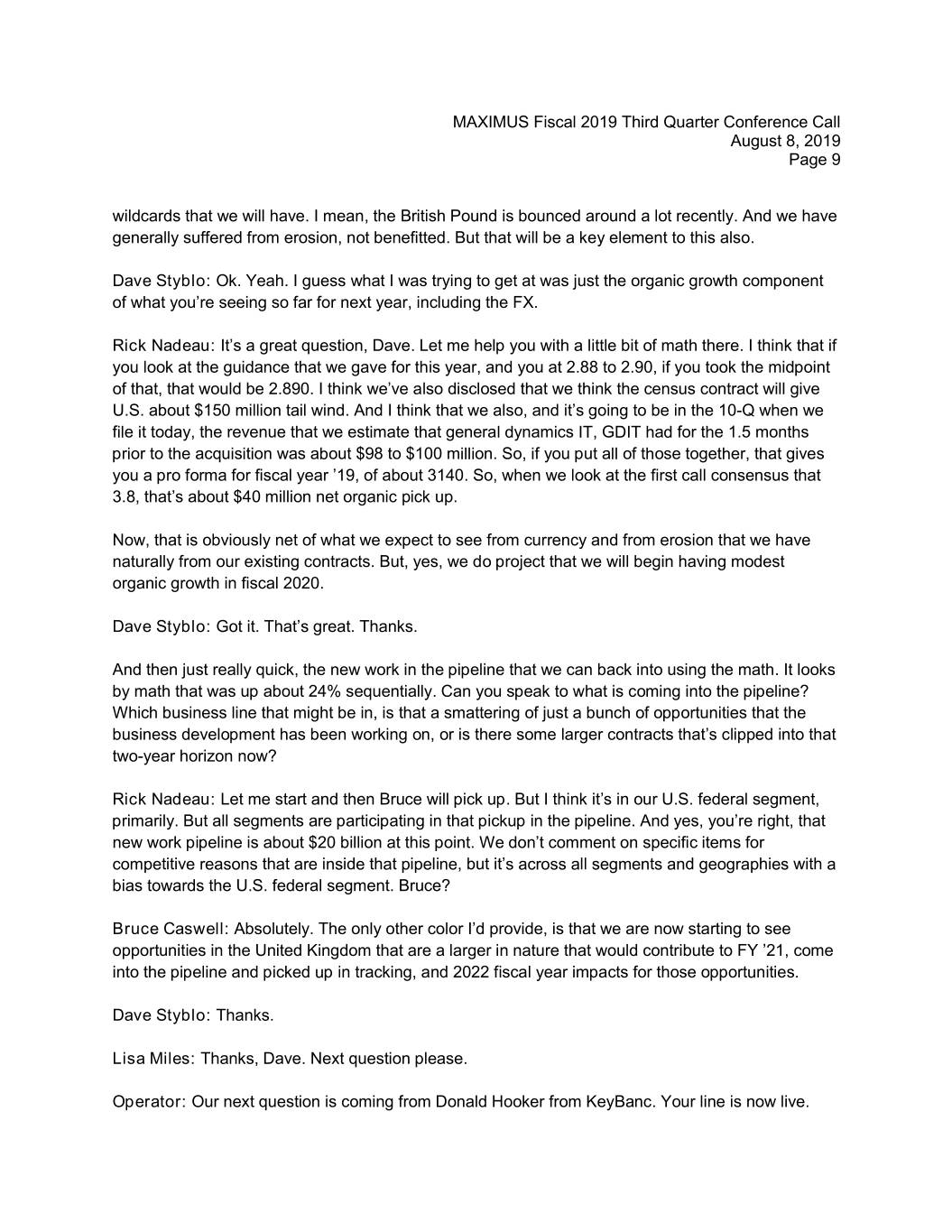
MAXIMUS Fiscal 2019 Third Quarter Conference Call August 8, 2019 Page 9 wildcards that we will have. I mean, the British Pound is bounced around a lot recently. And we have generally suffered from erosion, not benefitted. But that will be a key element to this also. Dave Styblo: Ok. Yeah. I guess what I was trying to get at was just the organic growth component of what you’re seeing so far for next year, including the FX. Rick Nadeau: It’s a great question, Dave. Let me help you with a little bit of math there. I think that if you look at the guidance that we gave for this year, and you at 2.88 to 2.90, if you took the midpoint of that, that would be 2.890. I think we’ve also disclosed that we think the census contract will give U.S. about $150 million tail wind. And I think that we also, and it’s going to be in the 10-Q when we file it today, the revenue that we estimate that general dynamics IT, GDIT had for the 1.5 months prior to the acquisition was about $98 to $100 million. So, if you put all of those together, that gives you a pro forma for fiscal year ’19, of about 3140. So, when we look at the first call consensus that 3.8, that’s about $40 million net organic pick up. Now, that is obviously net of what we expect to see from currency and from erosion that we have naturally from our existing contracts. But, yes, we do project that we will begin having modest organic growth in fiscal 2020. Dave Styblo: Got it. That’s great. Thanks. And then just really quick, the new work in the pipeline that we can back into using the math. It looks by math that was up about 24% sequentially. Can you speak to what is coming into the pipeline? Which business line that might be in, is that a smattering of just a bunch of opportunities that the business development has been working on, or is there some larger contracts that’s clipped into that two-year horizon now? Rick Nadeau: Let me start and then Bruce will pick up. But I think it’s in our U.S. federal segment, primarily. But all segments are participating in that pickup in the pipeline. And yes, you’re right, that new work pipeline is about $20 billion at this point. We don’t comment on specific items for competitive reasons that are inside that pipeline, but it’s across all segments and geographies with a bias towards the U.S. federal segment. Bruce? Bruce Caswell: Absolutely. The only other color I’d provide, is that we are now starting to see opportunities in the United Kingdom that are a larger in nature that would contribute to FY ’21, come into the pipeline and picked up in tracking, and 2022 fiscal year impacts for those opportunities. Dave Styblo: Thanks. Lisa Miles: Thanks, Dave. Next question please. Operator: Our next question is coming from Donald Hooker from KeyBanc. Your line is now live.
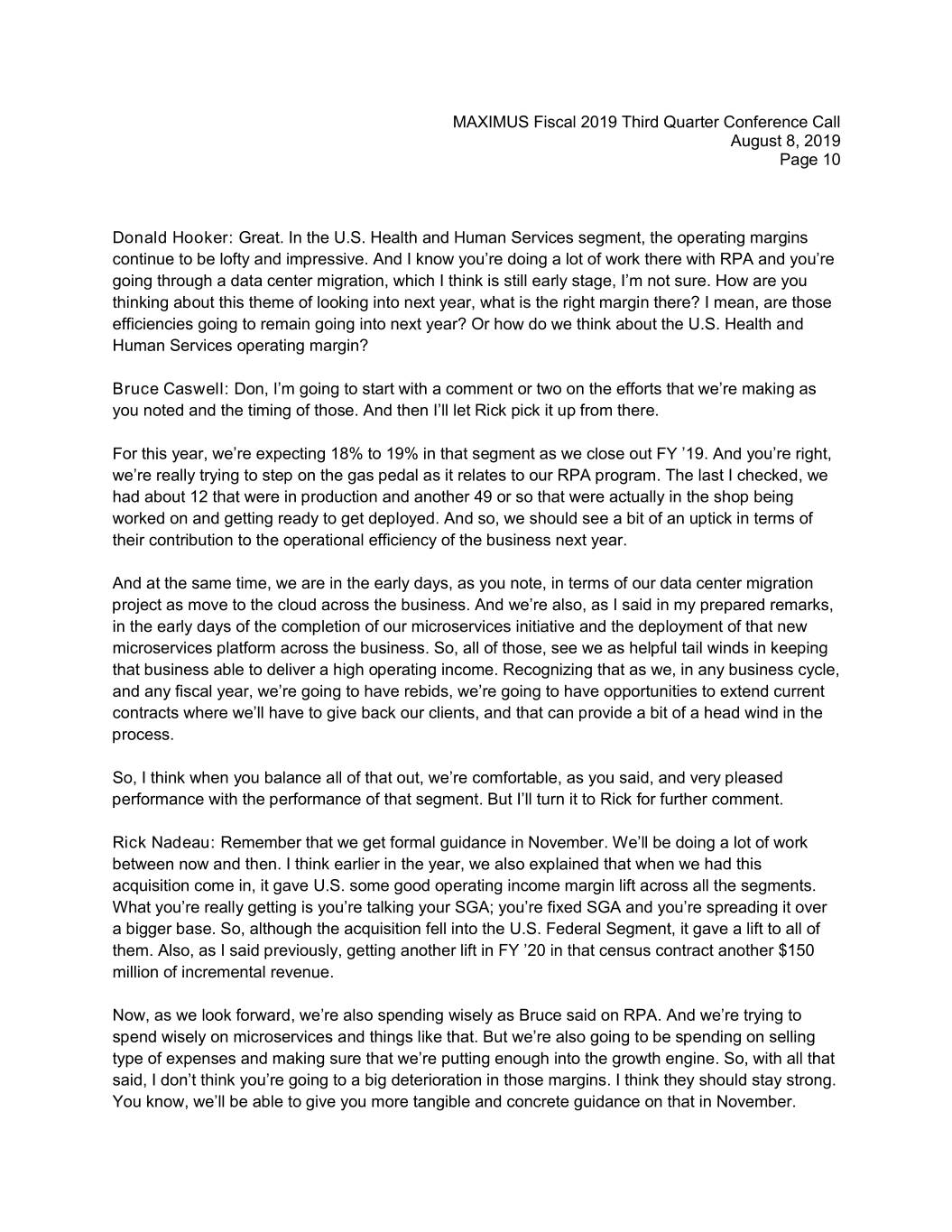
MAXIMUS Fiscal 2019 Third Quarter Conference Call August 8, 2019 Page 10 Donald Hooker: Great. In the U.S. Health and Human Services segment, the operating margins continue to be lofty and impressive. And I know you’re doing a lot of work there with RPA and you’re going through a data center migration, which I think is still early stage, I’m not sure. How are you thinking about this theme of looking into next year, what is the right margin there? I mean, are those efficiencies going to remain going into next year? Or how do we think about the U.S. Health and Human Services operating margin? Bruce Caswell: Don, I’m going to start with a comment or two on the efforts that we’re making as you noted and the timing of those. And then I’ll let Rick pick it up from there. For this year, we’re expecting 18% to 19% in that segment as we close out FY ’19. And you’re right, we’re really trying to step on the gas pedal as it relates to our RPA program. The last I checked, we had about 12 that were in production and another 49 or so that were actually in the shop being worked on and getting ready to get deployed. And so, we should see a bit of an uptick in terms of their contribution to the operational efficiency of the business next year. And at the same time, we are in the early days, as you note, in terms of our data center migration project as move to the cloud across the business. And we’re also, as I said in my prepared remarks, in the early days of the completion of our microservices initiative and the deployment of that new microservices platform across the business. So, all of those, see we as helpful tail winds in keeping that business able to deliver a high operating income. Recognizing that as we, in any business cycle, and any fiscal year, we’re going to have rebids, we’re going to have opportunities to extend current contracts where we’ll have to give back our clients, and that can provide a bit of a head wind in the process. So, I think when you balance all of that out, we’re comfortable, as you said, and very pleased performance with the performance of that segment. But I’ll turn it to Rick for further comment. Rick Nadeau: Remember that we get formal guidance in November. We’ll be doing a lot of work between now and then. I think earlier in the year, we also explained that when we had this acquisition come in, it gave U.S. some good operating income margin lift across all the segments. What you’re really getting is you’re talking your SGA; you’re fixed SGA and you’re spreading it over a bigger base. So, although the acquisition fell into the U.S. Federal Segment, it gave a lift to all of them. Also, as I said previously, getting another lift in FY ’20 in that census contract another $150 million of incremental revenue. Now, as we look forward, we’re also spending wisely as Bruce said on RPA. And we’re trying to spend wisely on microservices and things like that. But we’re also going to be spending on selling type of expenses and making sure that we’re putting enough into the growth engine. So, with all that said, I don’t think you’re going to a big deterioration in those margins. I think they should stay strong. You know, we’ll be able to give you more tangible and concrete guidance on that in November.
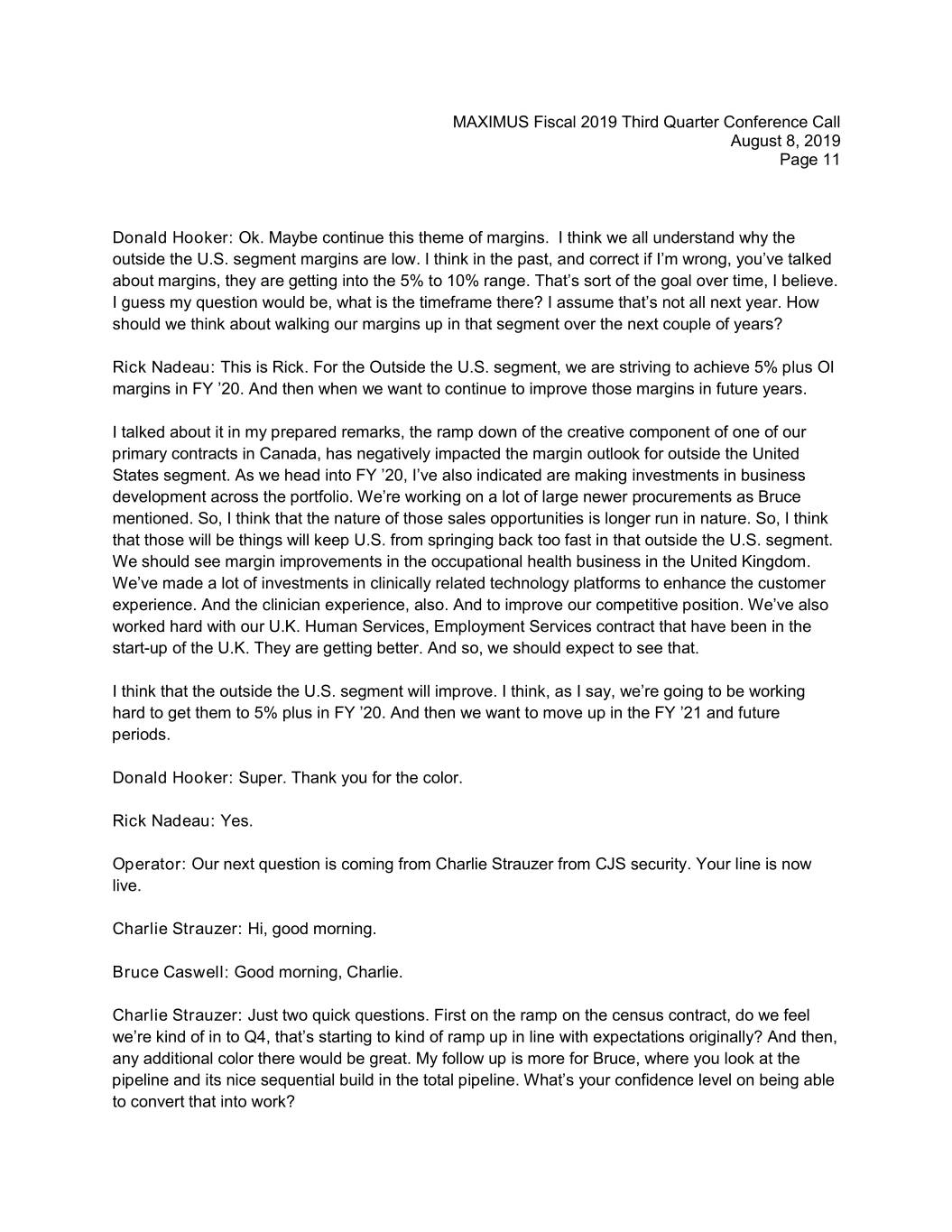
MAXIMUS Fiscal 2019 Third Quarter Conference Call August 8, 2019 Page 11 Donald Hooker: Ok. Maybe continue this theme of margins. I think we all understand why the outside the U.S. segment margins are low. I think in the past, and correct if I’m wrong, you’ve talked about margins, they are getting into the 5% to 10% range. That’s sort of the goal over time, I believe. I guess my question would be, what is the timeframe there? I assume that’s not all next year. How should we think about walking our margins up in that segment over the next couple of years? Rick Nadeau: This is Rick. For the Outside the U.S. segment, we are striving to achieve 5% plus OI margins in FY ’20. And then when we want to continue to improve those margins in future years. I talked about it in my prepared remarks, the ramp down of the creative component of one of our primary contracts in Canada, has negatively impacted the margin outlook for outside the United States segment. As we head into FY ’20, I’ve also indicated are making investments in business development across the portfolio. We’re working on a lot of large newer procurements as Bruce mentioned. So, I think that the nature of those sales opportunities is longer run in nature. So, I think that those will be things will keep U.S. from springing back too fast in that outside the U.S. segment. We should see margin improvements in the occupational health business in the United Kingdom. We’ve made a lot of investments in clinically related technology platforms to enhance the customer experience. And the clinician experience, also. And to improve our competitive position. We’ve also worked hard with our U.K. Human Services, Employment Services contract that have been in the start-up of the U.K. They are getting better. And so, we should expect to see that. I think that the outside the U.S. segment will improve. I think, as I say, we’re going to be working hard to get them to 5% plus in FY ’20. And then we want to move up in the FY ’21 and future periods. Donald Hooker: Super. Thank you for the color. Rick Nadeau: Yes. Operator: Our next question is coming from Charlie Strauzer from CJS security. Your line is now live. Charlie Strauzer: Hi, good morning. Bruce Caswell: Good morning, Charlie. Charlie Strauzer: Just two quick questions. First on the ramp on the census contract, do we feel we’re kind of in to Q4, that’s starting to kind of ramp up in line with expectations originally? And then, any additional color there would be great. My follow up is more for Bruce, where you look at the pipeline and its nice sequential build in the total pipeline. What’s your confidence level on being able to convert that into work?
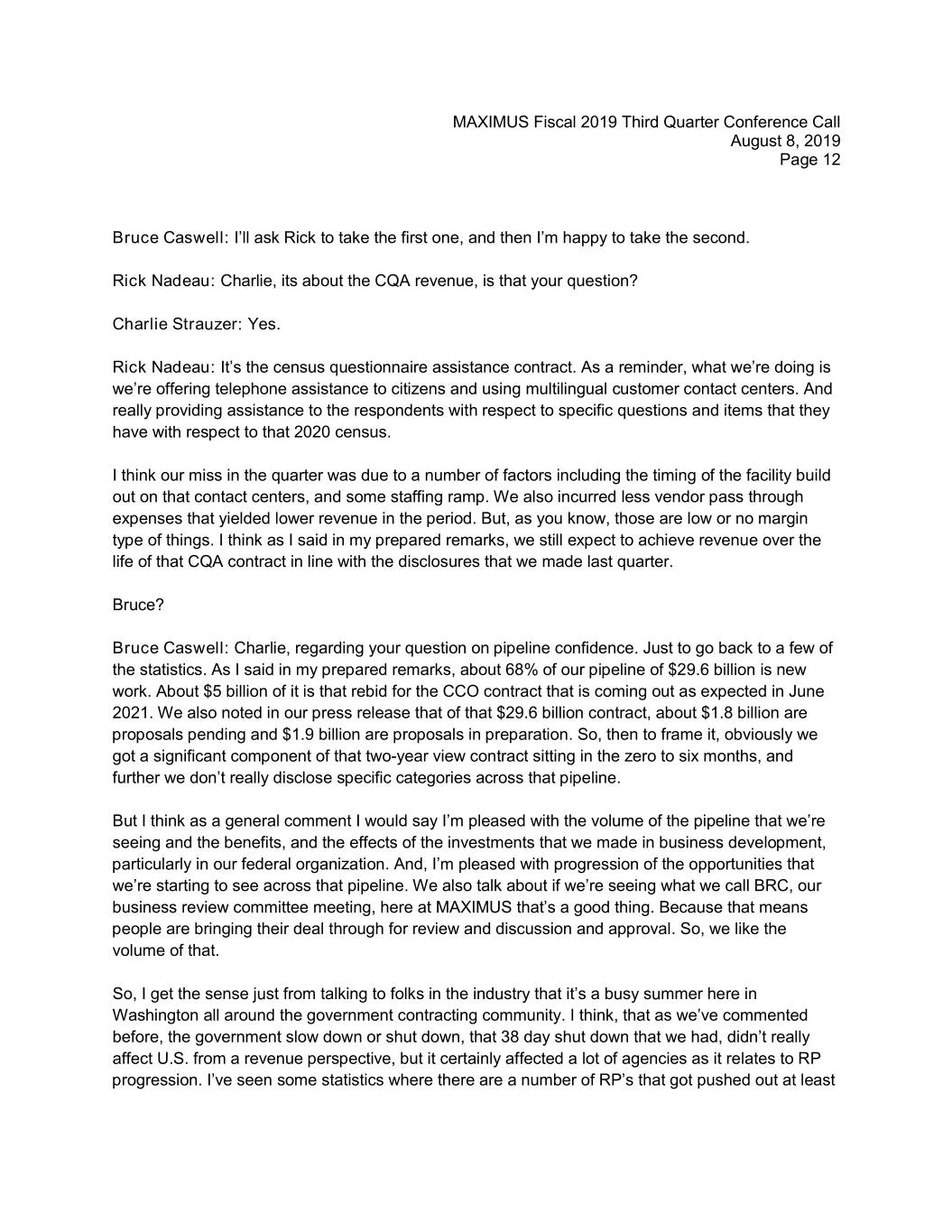
MAXIMUS Fiscal 2019 Third Quarter Conference Call August 8, 2019 Page 12 Bruce Caswell: I’ll ask Rick to take the first one, and then I’m happy to take the second. Rick Nadeau: Charlie, its about the CQA revenue, is that your question? Charlie Strauzer: Yes. Rick Nadeau: It’s the census questionnaire assistance contract. As a reminder, what we’re doing is we’re offering telephone assistance to citizens and using multilingual customer contact centers. And really providing assistance to the respondents with respect to specific questions and items that they have with respect to that 2020 census. I think our miss in the quarter was due to a number of factors including the timing of the facility build out on that contact centers, and some staffing ramp. We also incurred less vendor pass through expenses that yielded lower revenue in the period. But, as you know, those are low or no margin type of things. I think as I said in my prepared remarks, we still expect to achieve revenue over the life of that CQA contract in line with the disclosures that we made last quarter. Bruce? Bruce Caswell: Charlie, regarding your question on pipeline confidence. Just to go back to a few of the statistics. As I said in my prepared remarks, about 68% of our pipeline of $29.6 billion is new work. About $5 billion of it is that rebid for the CCO contract that is coming out as expected in June 2021. We also noted in our press release that of that $29.6 billion contract, about $1.8 billion are proposals pending and $1.9 billion are proposals in preparation. So, then to frame it, obviously we got a significant component of that two-year view contract sitting in the zero to six months, and further we don’t really disclose specific categories across that pipeline. But I think as a general comment I would say I’m pleased with the volume of the pipeline that we’re seeing and the benefits, and the effects of the investments that we made in business development, particularly in our federal organization. And, I’m pleased with progression of the opportunities that we’re starting to see across that pipeline. We also talk about if we’re seeing what we call BRC, our business review committee meeting, here at MAXIMUS that’s a good thing. Because that means people are bringing their deal through for review and discussion and approval. So, we like the volume of that. So, I get the sense just from talking to folks in the industry that it’s a busy summer here in Washington all around the government contracting community. I think, that as we’ve commented before, the government slow down or shut down, that 38 day shut down that we had, didn’t really affect U.S. from a revenue perspective, but it certainly affected a lot of agencies as it relates to RP progression. I’ve seen some statistics where there are a number of RP’s that got pushed out at least
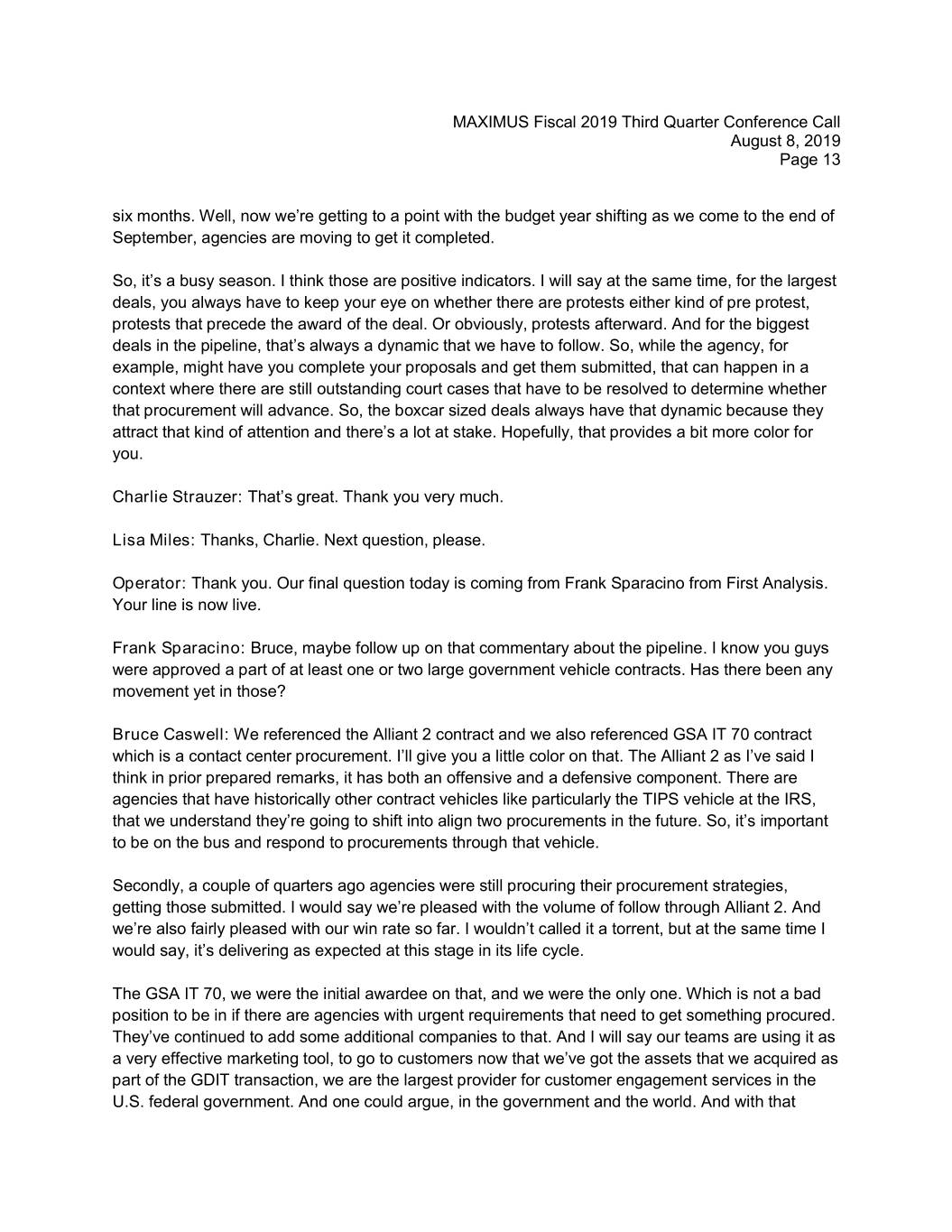
MAXIMUS Fiscal 2019 Third Quarter Conference Call August 8, 2019 Page 13 six months. Well, now we’re getting to a point with the budget year shifting as we come to the end of September, agencies are moving to get it completed. So, it’s a busy season. I think those are positive indicators. I will say at the same time, for the largest deals, you always have to keep your eye on whether there are protests either kind of pre protest, protests that precede the award of the deal. Or obviously, protests afterward. And for the biggest deals in the pipeline, that’s always a dynamic that we have to follow. So, while the agency, for example, might have you complete your proposals and get them submitted, that can happen in a context where there are still outstanding court cases that have to be resolved to determine whether that procurement will advance. So, the boxcar sized deals always have that dynamic because they attract that kind of attention and there’s a lot at stake. Hopefully, that provides a bit more color for you. Charlie Strauzer: That’s great. Thank you very much. Lisa Miles: Thanks, Charlie. Next question, please. Operator: Thank you. Our final question today is coming from Frank Sparacino from First Analysis. Your line is now live. Frank Sparacino: Bruce, maybe follow up on that commentary about the pipeline. I know you guys were approved a part of at least one or two large government vehicle contracts. Has there been any movement yet in those? Bruce Caswell: We referenced the Alliant 2 contract and we also referenced GSA IT 70 contract which is a contact center procurement. I’ll give you a little color on that. The Alliant 2 as I’ve said I think in prior prepared remarks, it has both an offensive and a defensive component. There are agencies that have historically other contract vehicles like particularly the TIPS vehicle at the IRS, that we understand they’re going to shift into align two procurements in the future. So, it’s important to be on the bus and respond to procurements through that vehicle. Secondly, a couple of quarters ago agencies were still procuring their procurement strategies, getting those submitted. I would say we’re pleased with the volume of follow through Alliant 2. And we’re also fairly pleased with our win rate so far. I wouldn’t called it a torrent, but at the same time I would say, it’s delivering as expected at this stage in its life cycle. The GSA IT 70, we were the initial awardee on that, and we were the only one. Which is not a bad position to be in if there are agencies with urgent requirements that need to get something procured. They’ve continued to add some additional companies to that. And I will say our teams are using it as a very effective marketing tool, to go to customers now that we’ve got the assets that we acquired as part of the GDIT transaction, we are the largest provider for customer engagement services in the U.S. federal government. And one could argue, in the government and the world. And with that
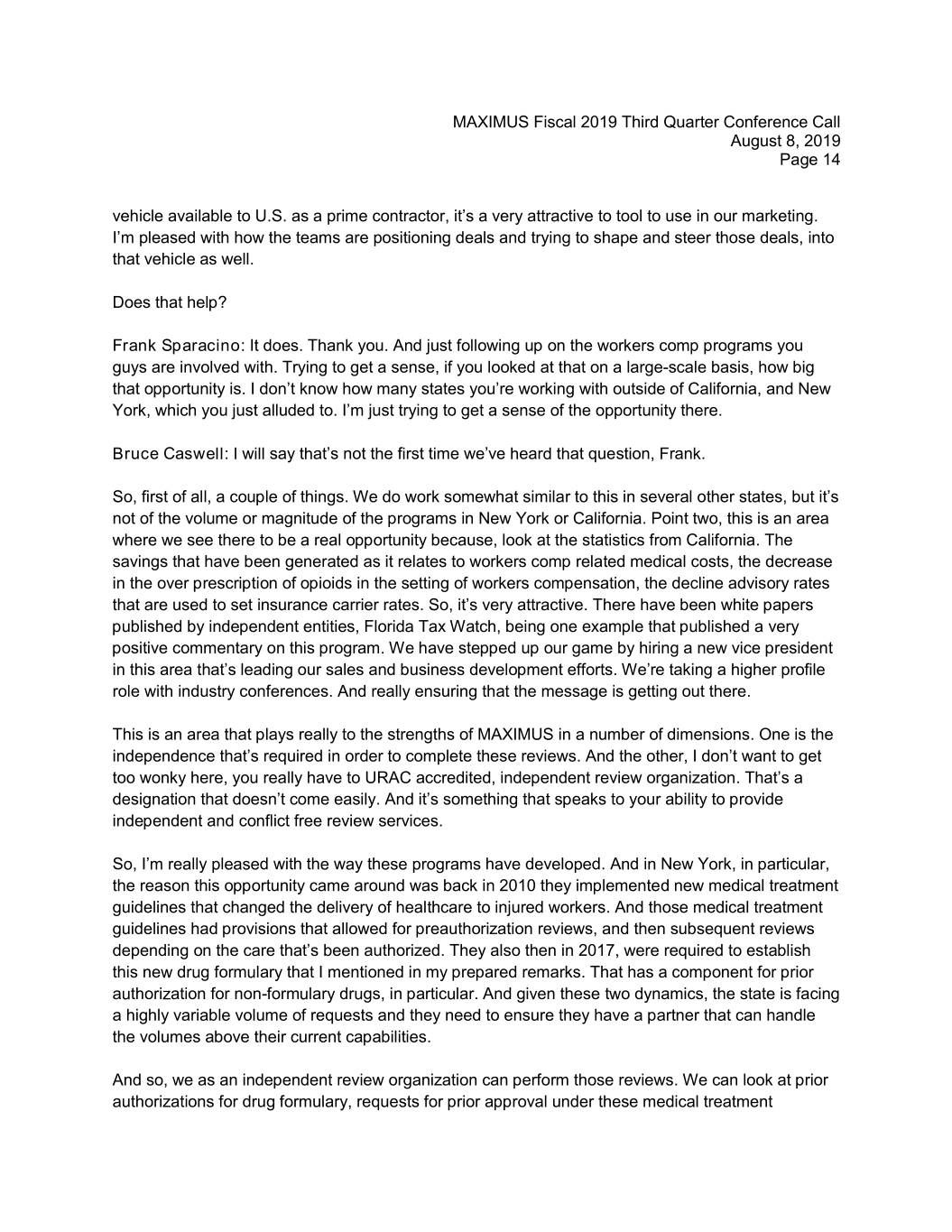
MAXIMUS Fiscal 2019 Third Quarter Conference Call August 8, 2019 Page 14 vehicle available to U.S. as a prime contractor, it’s a very attractive to tool to use in our marketing. I’m pleased with how the teams are positioning deals and trying to shape and steer those deals, into that vehicle as well. Does that help? Frank Sparacino: It does. Thank you. And just following up on the workers comp programs you guys are involved with. Trying to get a sense, if you looked at that on a large-scale basis, how big that opportunity is. I don’t know how many states you’re working with outside of California, and New York, which you just alluded to. I’m just trying to get a sense of the opportunity there. Bruce Caswell: I will say that’s not the first time we’ve heard that question, Frank. So, first of all, a couple of things. We do work somewhat similar to this in several other states, but it’s not of the volume or magnitude of the programs in New York or California. Point two, this is an area where we see there to be a real opportunity because, look at the statistics from California. The savings that have been generated as it relates to workers comp related medical costs, the decrease in the over prescription of opioids in the setting of workers compensation, the decline advisory rates that are used to set insurance carrier rates. So, it’s very attractive. There have been white papers published by independent entities, Florida Tax Watch, being one example that published a very positive commentary on this program. We have stepped up our game by hiring a new vice president in this area that’s leading our sales and business development efforts. We’re taking a higher profile role with industry conferences. And really ensuring that the message is getting out there. This is an area that plays really to the strengths of MAXIMUS in a number of dimensions. One is the independence that’s required in order to complete these reviews. And the other, I don’t want to get too wonky here, you really have to URAC accredited, independent review organization. That’s a designation that doesn’t come easily. And it’s something that speaks to your ability to provide independent and conflict free review services. So, I’m really pleased with the way these programs have developed. And in New York, in particular, the reason this opportunity came around was back in 2010 they implemented new medical treatment guidelines that changed the delivery of healthcare to injured workers. And those medical treatment guidelines had provisions that allowed for preauthorization reviews, and then subsequent reviews depending on the care that’s been authorized. They also then in 2017, were required to establish this new drug formulary that I mentioned in my prepared remarks. That has a component for prior authorization for non-formulary drugs, in particular. And given these two dynamics, the state is facing a highly variable volume of requests and they need to ensure they have a partner that can handle the volumes above their current capabilities. And so, we as an independent review organization can perform those reviews. We can look at prior authorizations for drug formulary, requests for prior approval under these medical treatment
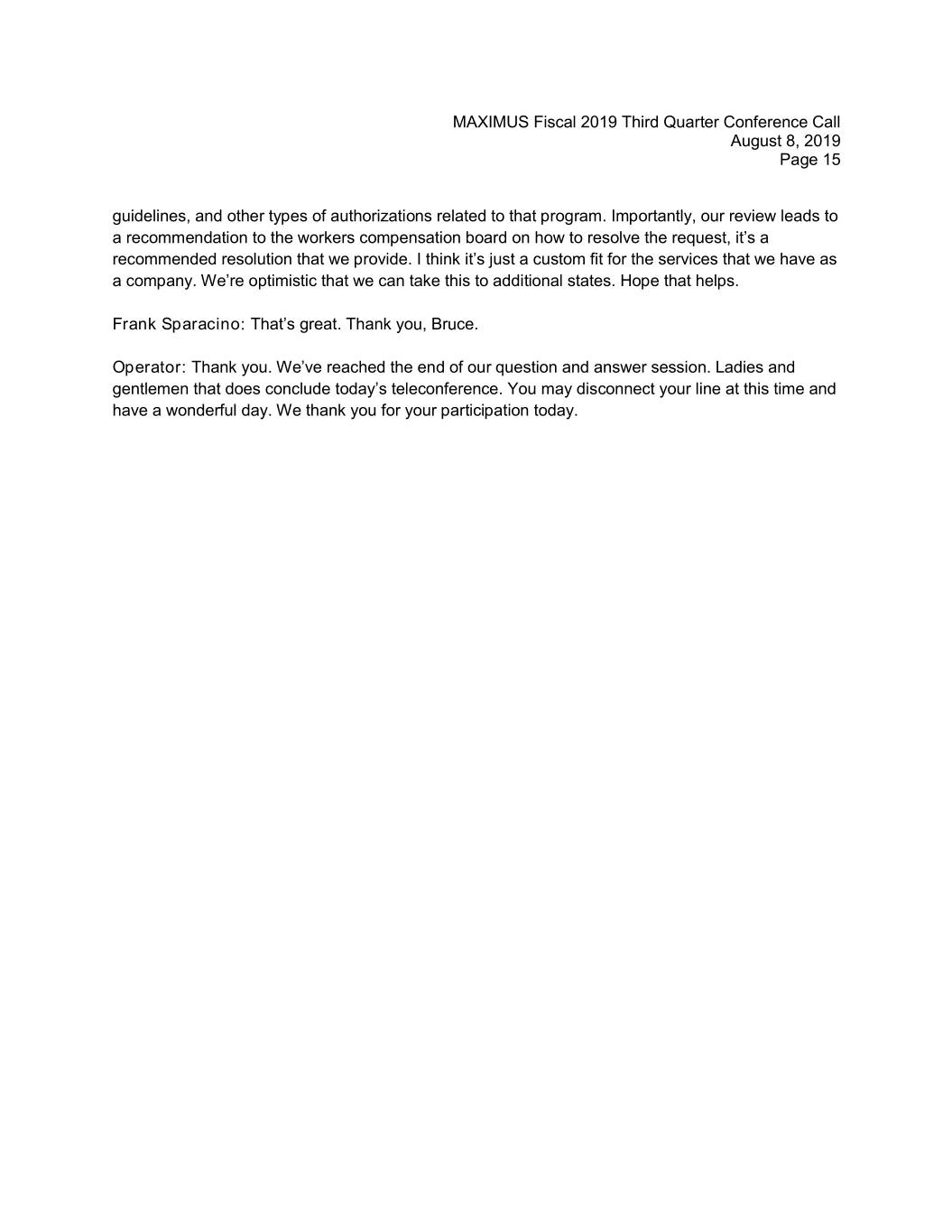
MAXIMUS Fiscal 2019 Third Quarter Conference Call August 8, 2019 Page 15 guidelines, and other types of authorizations related to that program. Importantly, our review leads to a recommendation to the workers compensation board on how to resolve the request, it’s a recommended resolution that we provide. I think it’s just a custom fit for the services that we have as a company. We’re optimistic that we can take this to additional states. Hope that helps. Frank Sparacino: That’s great. Thank you, Bruce. Operator: Thank you. We’ve reached the end of our question and answer session. Ladies and gentlemen that does conclude today’s teleconference. You may disconnect your line at this time and have a wonderful day. We thank you for your participation today.